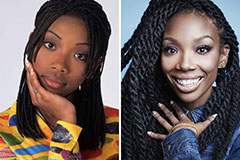Innovative Solutions in Assistive Modern Technology for Visual Impairment
The landscape of assistive innovation for aesthetic problems is evolving quickly, offering a range of ingenious options that boost accessibility and self-reliance. From sophisticated mobile phone applications that promote navigating to wearable tools designed for real-time guidance, these tools are reshaping the experiences of those with visual problems. The integration of smart home technologies and educational sources has the potential to foster greater community engagement. However, the implications of these advancements raise vital concerns concerning their access and performance in varied contexts, requiring a closer evaluation of their broader impact.
Improvements in Smartphone Applications
Recently, developments in smart device applications have dramatically transformed the landscape of assistive modern technology for individuals with aesthetic impairments. These applications take advantage of the effective sensors and abilities of modern mobile phones to give individuals with devices that enhance self-reliance and access in their lives.
Significant amongst these developments are applications created for object recognition, which use the smartphone's video camera to determine things and provide spoken descriptions. Such attributes empower users to browse their settings much more properly, whether identifying products in stores or situating personal valuables in the house. In addition, text-to-speech applications have improved considerably, making it possible for users to capture printed text with their gadget's cam and obtain split second sound responses, thereby facilitating reading and comprehension.
Navigation applications tailored for visually damaged customers have actually also arised, supplying acoustic advice and thorough area details. These devices give essential assistance for flexibility, permitting customers to go across unknown areas with confidence. Additionally, community-driven applications have fostered social interaction and source sharing amongst individuals with visual impairments, creating an encouraging network that boosts their lifestyle. On the whole, smart device applications have come to be crucial allies in promoting autonomy and accessibility for individuals with visual impairments.
Wearable Devices for Navigating
Wearable devices for navigating have become a groundbreaking solution for people with visual disabilities, offering hands-free help that enhances wheelchair and orientation. These gadgets generally make use of advanced innovations, consisting of GPS, ultrasonic sensors, and expert system, to supply real-time feedback and direction to customers as they navigate their atmosphere.
One notable example of wearable navigation innovation is wise glasses, which can identify obstacles and relay auditory or haptic feedback to the wearer, enabling risk-free and effective motion in different setups. Other gadgets, such as vests and belts furnished with sensing units, can likewise notify individuals of their environments by supplying informs regarding close-by items or modifications in terrain.
Furthermore, numerous wearable devices integrate with smartphone applications, enabling users to customize their navigating choices and get customized path recommendations. This personalization can significantly enhance the customer experience, encouraging people to travel with greater self-confidence and self-reliance.
As innovation continues to create, the possibility for wearable navigation devices to boost the lifestyle for people with visual problems stays considerable, leading the means for more easily accessible and inclusive environments.
Smart Home Modern Technology Combination

In addition, smart home appliances outfitted with tactile interfaces or auditory comments give intuitive interactions that cater particularly to the demands of those with aesthetic impairments. Smart refrigerators can reveal their components and expiration dates, while wise stoves can lead customers via the food preparation procedure with audio instructions.
Home automation systems, such as smart doorbells and security video cameras, provide assurance by allowing users to get notifies and gain access to live feeds by means of their mobile phones, improving personal security (AI-powered visual aids). Furthermore, combination with tablets and smartphones ensures that users can manage their home setting from anywhere within their properties
As clever home modern technology proceeds to progress, it holds the prospective to transform the living experiences of people with aesthetic disabilities, promoting independence and improving lifestyle in a significantly linked world.

Educational Tools and Resources
Access to reliable academic tools and sources is critical for people with visual impairments, as it encourages them to involve fully in their learning experiences. Numerous assistive modern technologies have actually been established to improve accessibility and foster independent learning. Display readers, as an example, convert message right into speech, enabling pupils to gain access to digital web content seamlessly. AI-powered visual aids. Furthermore, refreshable braille display screens give tactile responses, making it much easier for students to communicate with created material.
Furthermore, instructional software particularly made for visually impaired individuals supplies features such as high-contrast modes and personalized message sizes. These tools fit varied learning styles and make sure that pupils can customize their educational experience to their requirements.
Moreover, accessibility to digital collections and audio publications increases the series of available knowing materials, allowing trainees to discover topics detailed without the constraints enforced by traditional print resources. Collaborative platforms that incorporate ease of access functions likewise assist in team jobs, making sure that aesthetically damaged trainees can contribute meaningfully together with their peers.
Neighborhood Support and Interaction
A robust network of community support and engagement is essential for individuals with visual problems, cultivating a comprehensive setting where they can prosper. Neighborhood organizations, local advocacy teams, and volunteers play a crucial function in offering resources, information, and friendship, which are crucial anonymous for improving the lifestyle for those influenced by visual impairments.
Interaction tasks such as workshops, get-togethers, and support system not just help with skill growth but also promote social communication, lowering feelings of isolation. These efforts urge people to share successes, challenges, and experiences, thus enhancing neighborhood bonds. In addition, collaborations with neighborhood businesses can lead to greater availability in public areas, additionally incorporating people with aesthetic problems right into the area.
Modern technology also enhances community engagement through online platforms that provide virtual support system and resources, allowing people to attach despite geographical obstacles. By harnessing both digital and in-person solutions, communities can create an extensive support network. Ultimately, fostering collaboration amongst numerous stakeholders-- consisting of households, educators, and healthcare specialists-- makes certain that people with visual impairments obtain the all natural assistance required to navigate day-to-day live successfully and with dignity.
Conclusion
Cutting-edge remedies in assistive innovation for visual problems dramatically improve the high quality of life for individuals encountering these difficulties. The integration of smart device applications, wearable gadgets, smart home modern technology, and academic tools cultivates higher freedom and availability. Community support and engagement more equip aesthetically impaired people, promoting inclusivity and engagement in various elements of life. linked here Collectively, these innovations over here not only change day-to-day experiences however additionally pave the method for an extra equitable culture.
The landscape of assistive modern technology for aesthetic impairment is developing quickly, offering an array of innovative services that improve availability and freedom. Community-driven applications have actually fostered social interaction and resource sharing among individuals with visual disabilities, producing a helpful network that boosts their top quality of life. On the whole, smart device applications have actually become essential allies in promoting autonomy and ease of access for individuals with visual impairments.
Many individuals with visual impairments are finding better freedom via the assimilation of clever home modern technology.Cutting-edge options in assistive innovation for visual disability considerably enhance the quality of life for people encountering these obstacles.
 Michael J. Fox Then & Now!
Michael J. Fox Then & Now! Brandy Then & Now!
Brandy Then & Now! Mackenzie Rosman Then & Now!
Mackenzie Rosman Then & Now! Karyn Parsons Then & Now!
Karyn Parsons Then & Now! Kerri Strug Then & Now!
Kerri Strug Then & Now!